A Knowledge Graph-Driven Analysis of the Interlinkages among the Sustainable Development Goal Indicators in Different Spatial Resolutions
Abstract
1. Introduction
2. Related Work
2.1. SDG Interlinkages
2.2. SDG Knowledge Management
2.3. Motivation and Main Contribution
3. SDG Interlinkage Analysis over a Knowledge Graph
3.1. SDG Indicators Overview
3.2. Overview of the SustainGraph
4. Methodology
4.1. Selection of Representative Set of Indicators
4.2. Quality Data Assessment of Indicators
- Limited reporting years available: This type of indicator will not be accepted in any time range, if, even for the minimum examined time range do not satisfy the constraint (4).
- Majority of data in the examined range: Indicators with reporting gaps can be accepted in the examined time range only if they have most of their data, namely over 60% of their total data, in this time range. This constraint verifies that there is no other range where the indicator can be accepted.
4.3. Imputation of Missing Values
4.4. Correlation Analysis
5. Analysis Results
5.1. Selection of Indicators and Data Processing
5.2. Examination of Interlinkages at National Level
5.2.1. Correlation Analysis among the SDG indicators
5.2.2. Correlation Analysis among the SDGs
5.3. Examination of Interlinkages at Regional Level
6. Discussion
7. Conclusions
Author Contributions
Funding
Institutional Review Board Statement
Informed Consent Statement
Data Availability Statement
Conflicts of Interest
Appendix A
| Goal 1: NO POVERTY |
| 1.1.1: Proportion of the population living below the international poverty line by sex, age, employment status and geographic location (urban/rural) |
| 1.2.1: Proportion of population living below the national poverty line, by sex and age |
| 1.2.2: Proportion of men, women and children of all ages living in poverty in all its dimensions according to national definitions |
| 1.4.1: Proportion of population living in households with access to basic services |
| 1.a.1: Total official development assistance grants from all donors that focus on poverty reduction as a share of the recipient country’s gross national income |
| Goal 2: ZERO HUNGER |
| 2.1.1: Prevalence of undernourishment |
| 2.1.2: Prevalence of moderate or severe food insecurity in the population, based on the Food Insecurity Experience Scale (FIES) |
| 2.2.3: Prevalence of anaemia in women aged 15 to 49 years, by pregnancy status (percentage) |
| 2.3.1: Volume of production per labour unit by classes of farming/pastoral/forestry enterprise size |
| 2.5.1: Number of (a) plant and (b) animal genetic resources for food and agriculture secured in either medium- or long-term conservation facilities |
| 2.5.2: Proportion of local breeds classified as being at risk of extinction |
| 2.a.1: The agriculture orientation index for government expenditures |
| 2.c.1: Indicator of food price anomalies |
| Goal 3: GOOD HEALTH AND WELL-BEING |
| 3.1.1: Maternal mortality ratio |
| 3.1.2: Proportion of births attended by skilled health personnel |
| 3.2.1: Under-5 mortality rate |
| 3.2.2: Neonatal mortality rate |
| 3.3.1: Number of new HIV infections per 1,000 uninfected population, by sex, age and key populations |
| 3.3.2: Tuberculosis incidence per 100,000 population |
| 3.3.5: Number of people requiring interventions against neglected tropical diseases |
| 3.a.1: Age-standardized prevalence of current tobacco use among persons aged 15 years and older |
| 3.b.1: Proportion of the target population covered by all vaccines included in their national programme |
| 3.c.1: Health worker density and distribution |
| 3.d.1: International Health Regulations (IHR) capacity and health emergency preparedness |
| Goal 4: QUALITY EDUCATION |
| 4.1.2: Completion rate (primary, lower secondary, upper secondary education) |
| 4.2.2: Participation rate in organized learning (one year before the official primary entry age), by sex |
| 4.3.1: Participation rate of youth and adults in formal and non-formal education and training in the previous 12 months, by sex |
| 4.4.1: Proportion of youth and adults with information and communications technology (ICT) skills, by type of skill |
| 4.5.1: Parity indices (female/male, rural/urban, bottom/top wealth quintile and others such as disability status, indigenous peoples and conflict-affected, as data become available) for all education indicators on this list that can be disaggregated |
| Goal 5: GENDER EQUALITY |
| 5.5.1: Proportion of seats held by women in (a) national parliaments and (b) local governments |
| 5.5.2: Proportion of women in managerial positions |
| Goal 6: CLEAN WATER AND SANITATION |
| 6.1.1: Proportion of population using safely managed drinking water services |
| 6.2.1: Proportion of population using (a) safely managed sanitation services and (b) a hand-washing facility with soap and water |
| 6.4.1: Change in water-use efficiency over time |
| 6.4.2: Level of water stress: freshwater withdrawal as a proportion of available freshwater resources |
| 6.6.1: Change in the extent of water-related ecosystems over time |
| Goal 7: AFFORDABLE AND CLEAN ENERGY |
| 7.1.1: Proportion of population with access to electricity |
| 7.1.2: Proportion of population with primary reliance on clean fuels and technology |
| 7.2.1: Renewable energy share in the total final energy consumption |
| 7.3.1: Energy intensity measured in terms of primary energy and GDP |
| Goal 8: DECENT WORK AND ECONOMIC GROWTH |
| 8.1.1: Annual growth rate of real GDP per capita |
| 8.2.1: Annual growth rate of real GDP per employed person |
| 8.3.1: Proportion of informal employment in total employment, by sector and sex |
| 8.5.2: Unemployment rate, by sex, age and persons with disabilities |
| 8.6.1: Proportion of youth (aged 15–24 years) not in education, employment or training |
| 8.8.1: Fatal and non-fatal occupational injuries per 100,000 workers, by sex and migrant status |
| 8.8.2: Level of national compliance with labour rights (freedom of association and collective bargaining) based on International Labour Organization (ILO) textual sources and national legislation, by sex and migrant status |
| 8.9.1: Tourism direct GDP as a proportion of total GDP and in growth rate |
| 8.10.1: (a) Number of commercial bank branches per 100,000 adults and (b) number of automated teller machines (ATMs) per 100,000 adults |
| 8.a.1: Aid for Trade commitments and disbursements |
| Goal 9: INDUSTRY, INNOVATION AND INFRASTRUCTURE |
| 9.1.2: Passenger and freight volumes, by mode of transport |
| 9.2.1: Manufacturing value added as a proportion of GDP and per capita |
| 9.2.2: Manufacturing employment as a proportion of total employment |
| 9.3.1: Proportion of small-scale industries in total industry value added |
| 9.4.1: CO2 emission per unit of value added |
| 9.b.1: Proportion of medium and high-tech industry value added in total value added |
| 9.5.1: Research and development expenditure as a proportion of GDP |
| 9.5.2: Researchers (in full-time equivalent) per million inhabitants |
| 9.c.1: Proportion of population covered by a mobile network, by technology |
| Goal 10: REDUCED INEQUALITIES |
| 10.2.1: Proportion of people living below 50 per cent of median income, by sex, age and persons with disabilities |
| 10.4.1: Labour share of GDP |
| 10.5.1: Financial Soundness Indicators |
| 10.7.4: Proportion of the population who are refugees, by country of origin |
| 10.a.1: Proportion of tariff lines applied to imports from least developed countries and developing countries with zero-tariff |
| 10.b.1: Total resource flows for development, by recipient and donor countries and type of flow (e.g., official development assistance, foreign direct investment and other flows) |
| Goal 11: SUSTAINABLE CITIES AND COMMUNITIES |
| 11.6.2: Annual mean levels of fine particulate matter (e.g., PM2.5 and PM10) in cities (population weighted) |
| Goal 12: RESPONSIBLE CONSUMPTION AND PRODUCTION |
| 12.2.2: Domestic material consumption, domestic material consumption per capita, and domestic material consumption per GDP |
| 12.4.2: (a) Hazardous waste generated per capita; and (b) proportion of hazardous waste treated, by type of treatment |
| 12.5.1: National recycling rate, tons of material recycled |
| 12.b.1: Implementation of standard accounting tools to monitor the economic and environmental aspects of tourism sustainability |
| 12.c.1: Amount of fossil-fuel subsidies (production and consumption) per unit of GDP |
| Goal 13: CLIMATE ACTION |
| 13.1.1: Number of deaths, missing persons and directly affected persons attributed to disasters per 100,000 population |
| 13.2.2: Total greenhouse gas emissions per year |
| Goal 14: LIFE BELOW WATER |
| 14.1.1: (a) Index of coastal eutrophication; and (b) plastic debris density |
| 14.5.1: Coverage of protected areas in relation to marine areas |
| 14.7.1: Sustainable fisheries as a proportion of GDP in small island developing States, least developed countries and all countries |
| Goal 15: LIFE ON LAND |
| 15.1.1: Forest area as a proportion of total land area |
| 15.1.2: Proportion of important sites for terrestrial and freshwater biodiversity that are covered by protected areas, by ecosystem type |
| 15.2.1: Progress towards sustainable forest management |
| 15.4.1: Coverage by protected areas of important sites for mountain biodiversity |
| 15.5.1: Red List Index |
| 15.6.1: Number of countries that have adopted legislative, administrative and policy frameworks to ensure fair and equitable sharing of benefits |
| 15.b.1: (a) Official development assistance on conservation and sustainable use of biodiversity; and (b) revenue generated and finance mobilized from biodiversity-relevant economic instruments |
| Goal 16: PEACE, JUSTICE AND STRONG INSTITUTIONS |
| 16.1.1: Number of victims of intentional homicide per 100,000 population, by sex and age |
| 16.2.2: Number of victims of human trafficking per 100,000 population, by sex, age and form of exploitation |
| 16.3.2: Unsentenced detainees as a proportion of overall prison population |
| 16.6.1: Primary government expenditures as a proportion of original approved budget, by sector (or by budget codes or similar) |
| 16.8.1: Proportion of members and voting rights of developing countries in international organizations |
| Goal 17: PARTNERSHIPS FOR THE GOALS |
| 17.1.1: Total government revenue as a proportion of GDP, by source |
| 17.1.2: Proportion of domestic budget funded by domestic taxes |
| 17.2.1: Net official development assistance, total and to least developed countries, as a proportion of the Organization for Economic Cooperation and Development (OECD) Development Assistance Committee donors’ gross national income (GNI) |
| 17.3.2: Volume of remittances (in United States dollars) as a proportion of total GDP |
| 17.6.1: Fixed Internet broadband subscriptions per 100 inhabitants, by speed |
| 17.7.1: Total amount of funding for developing countries to promote the development, transfer, dissemination and diffusion of environmentally sound technologies |
| 17.8.1: Proportion of individuals using the Internet |
| 17.11.1: Developing countries’ and least developed countries’ share of global exports |
| 17.12.1: Weighted average tariffs faced by developing countries, least developed countries and small island developing States |
| 17.13.1: Macroeconomic Dashboard |
| 17.18.1: Statistical capacity indicator for Sustainable Development Goal monitoring |
| Goal 1: NO POVERTY |
| sdg_01_10: People At Risk Of Poverty Or Social Exclusion |
| sdg_01_20: Persons At Risk Of Monetary Poverty After Social Transfers - Eu-Silc And Echp Surveys |
| sdg_01_31: Severe Material And Social Deprivation Rate By Age Group And Sex |
| sdg_01_40: People Living In Households With Very Low Work Intensity, By Age Group |
| sdg_01_41: In Work At-Risk-Of-Poverty Rate |
| sdg_01_50: Housing Cost Overburden Rate By Poverty Status |
| Goal 2: ZERO HUNGER |
| sdg_02_20: Agricultural Factor Income Per Annual Work Unit (Awu) (Source: Eurostat, Dg Agri) |
| sdg_02_30: Government Support To Agricultural Research And Development |
| sdg_02_40: Area Under Organic Farming |
| sdg_02_60: Ammonia Emissions From Agriculture (Source: Eea) |
| Goal 3: GOOD HEALTH AND WELL-BEING |
| sdg_03_11: Healthy Life Years At Birth By Sex |
| sdg_03_20: Share Of People With Good Or Very Good Perceived Health By Sex |
| sdg_03_41: Standardised Death Rate Due To Tuberculosis, Hiv And Hepatitis By Type Of Disease |
| sdg_03_42: Standardised Preventable And Treatable Mortality |
| sdg_03_60: Self-Reported Unmet Need For Medical Examination And Care By Sex |
| Goal 4: QUALITY EDUCATION |
| sdg_04_10: Early Leavers From Education And Training By Sex |
| sdg_04_20: Tertiary Educational Attainment By Sex |
| sdg_04_31: Participation In Early Childhood Education By Sex (Children Aged 3 And Over) |
| sdg_04_60: Adult Participation In Learning In The Past Four Weeks By Sex |
| Goal 5: GENDER EQUALITY |
| sdg_05_20: Gender Pay Gap In Unadjusted Form |
| sdg_05_30: Gender Employment Gap, By Type Of Employment |
| sdg_05_40: Persons Outside The Labour Force Due To Caring Responsibilities By Sex |
| sdg_05_50: Seats Held By Women In National Parliaments And Governments (Source: Eige) |
| sdg_05_60: Positions Held By Women In Senior Management Positions (Source: Eige) |
| Goal 6: CLEAN WATER AND SANITATION |
| sdg_06_10: Population Having Neither A Bath, Nor A Shower, Nor Indoor Flushing Toilet In Their Household By Poverty Status |
| sdg_06_20: Population Connected To At Least Secondary Wastewater Treatment |
| sdg_06_30: Biochemical Oxygen Demand In Rivers (Source: Eea) |
| sdg_06_40: Nitrate In Groundwater (Source: Eea) |
| sdg_06_50: Phosphate In Rivers (Source: Eea) |
| sdg_06_60: Water Exploitation Index, Plus (Wei+) (Source: Eea) |
| Goal 7: AFFORDABLE AND CLEAN ENERGY |
| sdg_07_10: Primary Energy Consumption |
| sdg_07_11: Final Energy Consumption |
| sdg_07_20: Final Energy Consumption In Households Per Capita |
| sdg_07_30: Energy Productivity |
| sdg_07_40: Share Of Renewable Energy In Gross Final Energy Consumption By Sector |
| sdg_07_50: Energy Import Dependency By Products |
| sdg_07_60: Population Unable To Keep Home Adequately Warm By Poverty Status |
| Goal 8: DECENT WORK AND ECONOMIC GROWTH |
| sdg_08_10: Real Gdp Per Capita |
| sdg_08_11: Investment Share Of Gdp By Institutional Sectors |
| sdg_08_20: Young People Neither In Employment Nor In Education And Training By Sex (Neet) |
| sdg_08_30: Employment Rate By Sex |
| sdg_08_40: Long-Term Unemployment Rate By Sex |
| sdg_08_60: Fatal Accidents At Work Per 100 000 Workers, By Sex |
| Goal 9: INDUSTRY, INNOVATION AND INFRASTRUCTURE |
| sdg_09_10: Gross Domestic Expenditure On R&D By Sector |
| sdg_09_30: R&D Personnel By Sector |
| sdg_09_40: Patent Applications To The European Patent Office By Applicants’/Inventors’ Country Of Residence (Source: Epo) |
| sdg_09_50: Share Of Buses And Trains In Inland Passenger Transport |
| sdg_09_60: Share Of Rail And Inland Waterways In Inland Freight Transport |
| sdg_09_70: Air Emission Intensity From Industry |
| Goal 10: REDUCED INEQUALITIES |
| sdg_10_10: Purchasing Power Adjusted Gdp Per Capita |
| sdg_10_20: Adjusted Gross Disposable Income Of Households Per Capita |
| sdg_10_30: Relative Median At-Risk-Of-Poverty Gap |
| sdg_10_41: Income Distribution |
| sdg_10_50: Income Share Of The Bottom 40 % Of The Population |
| sdg_10_60: Asylum Applications By State Of Procedure |
| Goal 11: SUSTAINABLE CITIES AND COMMUNITIES |
| sdg_11_11: Severe Housing Deprivation Rate By Poverty Status |
| sdg_11_20: Population Living In Households Considering That They Suffer From Noise, By Poverty Status |
| sdg_11_40: Road Traffic Deaths, By Type Of Roads (Source: Dg Move) |
| sdg_11_52: Premature Deaths Due To Exposure To Fine Particulate Matter (Pm2.5) (Source: Eea) |
| sdg_11_60: Recycling Rate Of Municipal Waste |
| Goal 12: RESPONSIBLE CONSUMPTION AND PRODUCTION |
| sdg_12_21: Raw Material Consumption (Rmc) |
| sdg_12_30: Average Co2 Emissions Per Km From New Passenger Cars (Source: Eea, Dg Clima) |
| sdg_12_41: Circular Material Use Rate |
| sdg_12_51: Generation Of Waste By Hazardousness |
| sdg_12_61: Gross Value Added In Environmental Goods And Services Sector |
| Goal 13: CLIMATE ACTION |
| sdg_13_10: Net Greenhouse Gas Emissions (Source: EEA) |
| sdg_13_21: Net Greenhouse Gas Emissions Of The Land Use, Land Use Change And Forestry (Lulucf) Sector |
| sdg_13_40: Climate-Related Economic Losses (Source: EEA) |
| sdg_13_50: Contribution To The International 100Bn Usd Commitment On Climate-Related Expending (Source: Dg Clima, Eionet) |
| sdg_13_60: Population Covered By The Covenant Of Mayors For Climate & Energy Signatories (Source: Covenant Of Mayors) |
| Goal 14: LIFE BELOW WATER |
| sdg_14_40: Bathing Sites With Excellent Water Quality By Locality (Source: Eea) |
| sdg_14_60: Marine Waters Affected By Eutrophication (Source: Cmems) |
| Goal 16: PEACE, JUSTICE AND STRONG INSTITUTIONS |
| sdg_16_10: Standardised Death Rate Due To Homicide By Sex |
| sdg_16_20: Population Reporting Occurrence Of Crime, Violence Or Vandalism In Their Area By Poverty Status |
| sdg_16_30: General Government Total Expenditure On Law Courts |
| sdg_16_40: Perceived Independence Of The Justice System (Source: Dg Comm) |
| sdg_16_50: Corruption Perceptions Index (Source: Transparency International) |
| sdg_16_60: Population With Confidence In Eu Institutions By Institution |
| Goal 17: PARTNERSHIPS FOR THE GOALS |
| sdg_17_10: Official Development Assistance As Share Of Gross National Income |
| sdg_17_20: Eu Financing To Developing Countries By Financing Source (Source: Oecd) |
| sdg_17_30: Eu Imports From Developing Countries By Country Income Groups |
| sdg_17_40: General Government Gross Debt |
| sdg_17_50: Share Of Environmental Taxes In Total Tax Revenues |
| sdg_17_60: High-Speed Internet Coverage, By Type Of Area |
References
- United Nations General Assembly. The Sustainable Development Goals. 2024. Available online: https://www.undp.org/sustainable-development-goals (accessed on 12 April 2024).
- Halkos, G.; Gkampoura, E.C. Where do we stand on the 17 Sustainable Development Goals? An overview on progress. Econ. Anal. Policy 2021, 70, 94–122. [Google Scholar] [CrossRef]
- Dawes, J. SDG interlinkage networks: Analysis, robustness, sensitivities, and hierarchies. World Dev. 2022, 149, 105693. [Google Scholar] [CrossRef]
- United Nations. Transforming Our World: The 2030 Agenda for Sustainable Development. 2024. Available online: https://sdgs.un.org/2030agenda (accessed on 12 April 2024).
- Bennich, T.; Persson, Å.; Beaussart, R.; Allen, C.; Malekpour, S. Recurring patterns of SDG interlinkages and how they can advance the 2030 Agenda. ONE Earth 2023, 6, 1465–1476. [Google Scholar] [CrossRef]
- Issa, L.; Mezher, T.; El Fadel, M. Can network analysis ascertain SDGs interlinkages towards evidence-based policy planning? A systematic critical assessment. Environ. Impact Assess. Rev. 2024, 104, 107295. [Google Scholar] [CrossRef]
- Cling, J.P.; Delecourt, C. Interlinkages between the Sustainable Development Goals. World Dev. Perspect. 2022, 25, 100398. [Google Scholar] [CrossRef]
- United Nations Statistics Division. The SDGs Geospatial Roadmap. 2024. Available online: https://unstats.un.org/unsd/statcom/53rd-session/documents/BG-3a-SDGs-Geospatial-Roadmap-E.pdf (accessed on 12 April 2024).
- López-Vargas, A.; Fuentes, M.; Vivar, M. Challenges and Opportunities of the Internet of Things for Global Development to Achieve the United Nations Sustainable Development Goals. IEEE Access 2020, 8, 37202–37213. [Google Scholar] [CrossRef]
- Jaber, M. IoT and machine learning for enabling sustainable development goals. Front. Commun. Netw. 2023, 4, 1219047. [Google Scholar] [CrossRef]
- Maheswar, R.; Kanagachidambaresan, G.R. Sustainable development through Internet of Things. Wirel. Netw. 2020, 26, 2305–2306. [Google Scholar] [CrossRef]
- Giuliani, G.; Mazzetti, P.; Santoro, M.; Nativi, S.; Van Bemmelen, J.; Colangeli, G.; Lehmann, A. Knowledge generation using satellite earth observations to support sustainable development goals (SDG): A use case on Land degradation. Int. J. Appl. Earth Obs. Geoinf. 2020, 88, 102068. [Google Scholar] [CrossRef]
- Kavvada, A.; Metternicht, G.; Kerblat, F.; Mudau, N.; Haldorson, M.; Laldaparsad, S.; Friedl, L.; Held, A.; Chuvieco, E. Towards delivering on the Sustainable Development Goals using Earth observations. Remote Sens. Environ. 2020, 247, 111930. [Google Scholar] [CrossRef]
- Warchold, A.; Pradhan, P.; Thapa, P.; Putra, M.P.I.F.; Kropp, J.P. Building a unified sustainable development goal database: Why does sustainable development goal data selection matter? Sustain. Dev. 2022, 30, 1278–1293. [Google Scholar] [CrossRef]
- Fotopoulou, E.; Mandilara, I.; Zafeiropoulos, A.; Laspidou, C.; Adamos, G.; Koundouri, P.; Papavassiliou, S. SustainGraph: A knowledge graph for tracking the progress and the interlinking among the sustainable development goals’ targets. Front. Environ. Sci. 2022, 10, 1003599. [Google Scholar] [CrossRef]
- Androna, C.M.; Mandilara, I.; Fotopoulou, E.; Giannakopoulou, K.; Zafeiropoulos, A.; Papavassiliou, S. Socio-environmental Spatial Data Reduction and Integration in Knowledge Graphs. In Proceedings of the PACET 2024: PAnhellenic Conference on Electronics and Telecommunications, Thessaloniki, Greece, 28–29 March 2024. [Google Scholar]
- Chen, M.; Chen, L.; Cheng, J.; Yu, J. Identifying interlinkages between urbanization and Sustainable Development Goals. Geogr. Sustain. 2022, 3, 339–346. [Google Scholar] [CrossRef]
- Song, J.; Jang, C.H. Unpacking the sustainable development goals (SDGs) interlinkages: A semantic network analysis of the SDGs targets. Sustain. Dev. 2023, 31, 2784–2796. [Google Scholar] [CrossRef]
- Hürlimann, M.; Guo, Z.; Puig-Polo, C.; Medina, V. Impacts of future climate and land cover changes on landslide susceptibility: Regional scale modelling in the Val d’Aran region (Pyrenees, Spain). Landslides 2022, 19, 99–118. [Google Scholar] [CrossRef]
- Ning, Y.; Liu, H.; Wang, H.; Zeng, Z.; Xiong, H. UUKG: Unified Urban Knowledge Graph Dataset for Urban Spatiotemporal Prediction. In Proceedings of the Advances in Neural Information Processing Systems; Oh, A., Neumann, T., Globerson, A., Saenko, K., Hardt, M., Levine, S., Eds.; Curran Associates, Inc.: Sydney, Australia, 2023; Volume 36, pp. 62442–62456. [Google Scholar]
- Liu, Y.; Ding, J.; Fu, Y.; Li, Y. UrbanKG: An Urban Knowledge Graph System. ACM Trans. Intell. Syst. Technol. 2023, 14, 60. [Google Scholar] [CrossRef]
- Janowicz, K.; Hitzler, P.; Li, W.; Rehberger, D.; Schildhauer, M.; Zhu, R.; Shimizu, C.; Fisher, C.K.; Cai, L.; Mai, G.; et al. Know, Know Where, KnowWhereGraph: A densely connected, cross-domain knowledge graph and geo-enrichment service stack for applications in environmental intelligence. AI Mag. 2022, 43, 30–39. [Google Scholar] [CrossRef]
- Allen, C.; Smith, M.; Rabiee, M.; Dahmm, H. A review of scientific advancements in datasets derived from big data for monitoring the Sustainable Development Goals. Sustain. Sci. 2021, 16, 1701–1716. [Google Scholar] [CrossRef]
- Mandilara, I.; Fotopoulou, E.; Androna, C.M.; Zafeiropoulos, A.; Papavassiliou, S. Knowledge Graph Data Enrichment Based on a Software Library for Text Mapping to the Sustainable Development Goals. In Proceedings of the TEXT2KG 2023: Second International Workshop on Knowledge Graph Generation from Text, Hersonissos, Greece, 28 May–1 June 2023. [Google Scholar]
- EU SDG Indicator Review. Available online: https://ec.europa.eu/eurostat/web/sdi/information-data (accessed on 12 April 2024).
- ARSINOE Project. ARSINOE H2020 Project: Climate Resilient Regions through Systemic Solutions and Innovations. 2023. Available online: https://arsinoe-project.eu/ (accessed on 12 April 2024).
- Eurostat. Methodological Manual on Territorial Typologies; Eurostat: Luxembourg, 2018. [Google Scholar]
- SustainGraph Gitlab Repository; Mandilara, I.; Androna, C.M.; Fotopoulou, E.; Zafeiropoulos, A. SustainGraph Gitlab Repository. 2024. Available online: https://gitlab.com/netmode/sustaingraph (accessed on 12 April 2024).
- SustainGraph API Gitlab Repository; Androna, C.M.; Mandilara, I.; Fotopoulou, E.; Zafeiropoulos, A. SustainGraph Gitlab Repository. 2024. Available online: https://gitlab.com/netmode/sustaingraph_api (accessed on 12 April 2024).
- SustainGraph Correlation Indicators Gitlab Repository; Mandilara, I.; Androna, C.M.; Fotopoulou, E.; Zafeiropoulos, A. SustainGraph Gitlab Repository. 2024. Available online: https://gitlab.com/netmode/sustaingraph-correlation-indicators (accessed on 12 April 2024).
- Batista, G.; Monard, M.C. A Study of K-Nearest Neighbour as an Imputation Method. In Proceedings of the Soft Computing Systems—Design, Management and Applications, HIS 2002, Santiago, Chile, 1–4 December 2002; Volume 30, pp. 251–260. [Google Scholar]
- Spearman, C. The Proof and Measurement of Association between Two Things. Am. J. Psychol. 1904, 15, 72–101. [Google Scholar] [CrossRef]
- Kroll, C.; Warchold, A.; Pradhan, P. Sustainable Development Goals (SDGs): Are we successful in turning trade-offs into synergies? Palgrave Commun. 2019, 5, 140. [Google Scholar] [CrossRef]
- Bellantuono, L.; Monaco, A.; Amoroso, N.; Aquaro, V.; Lombardi, A.; Tangaro, S.; Bellotti, R. Sustainable development goals: Conceptualization, communication and achievement synergies in a complex network framework. Appl. Netw. Sci. 2022, 7, 14. [Google Scholar] [CrossRef] [PubMed]
- Laumann, F.; von Kügelgen, J.; Kanashiro Uehara, T.H.; Barahona, M. Complex interlinkages, key objectives, and nexuses among the Sustainable Development Goals and climate change: A network analysis. Lancet Planet. Health 2022, 6, e422–e430. [Google Scholar] [CrossRef] [PubMed]
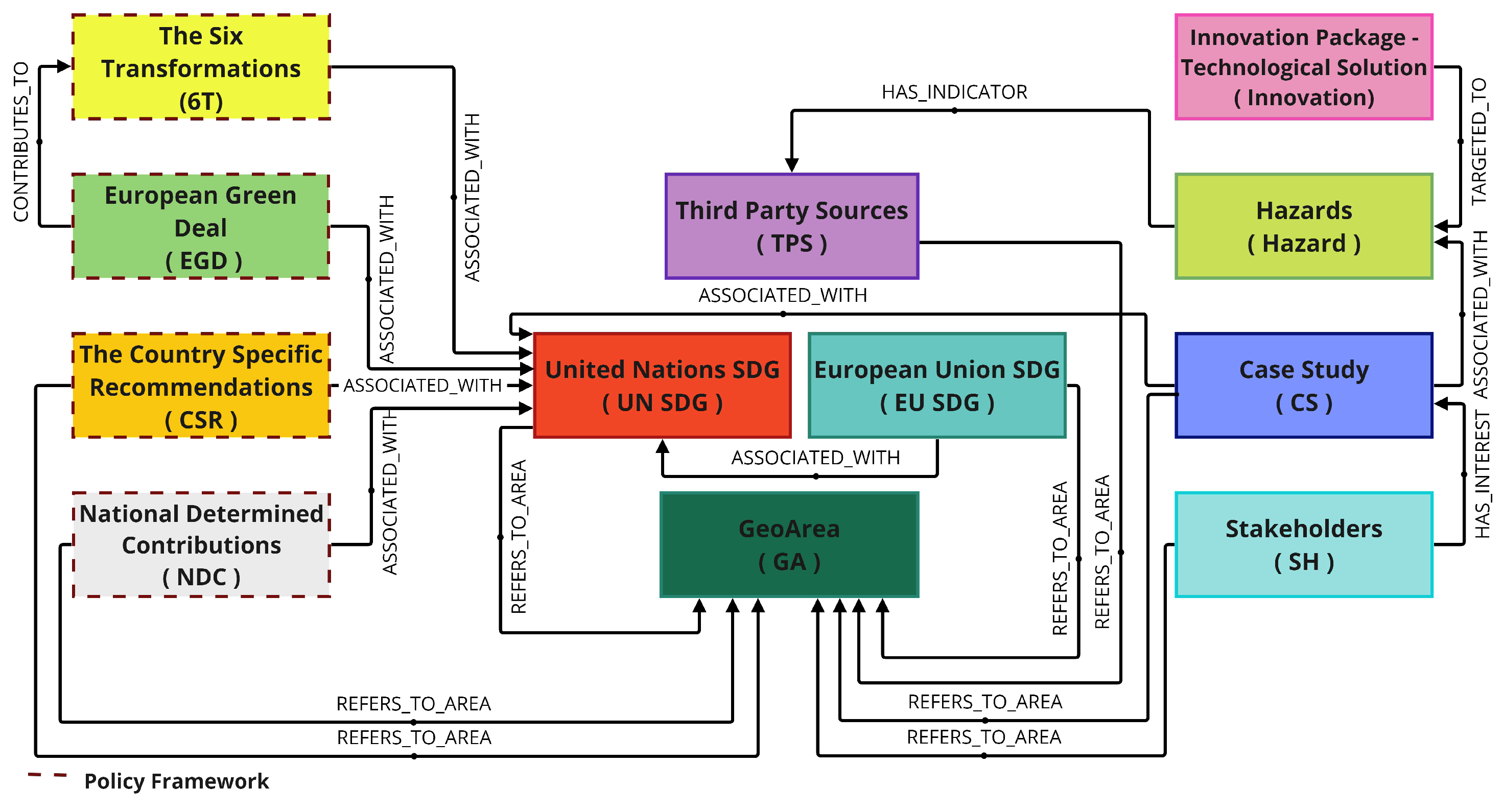



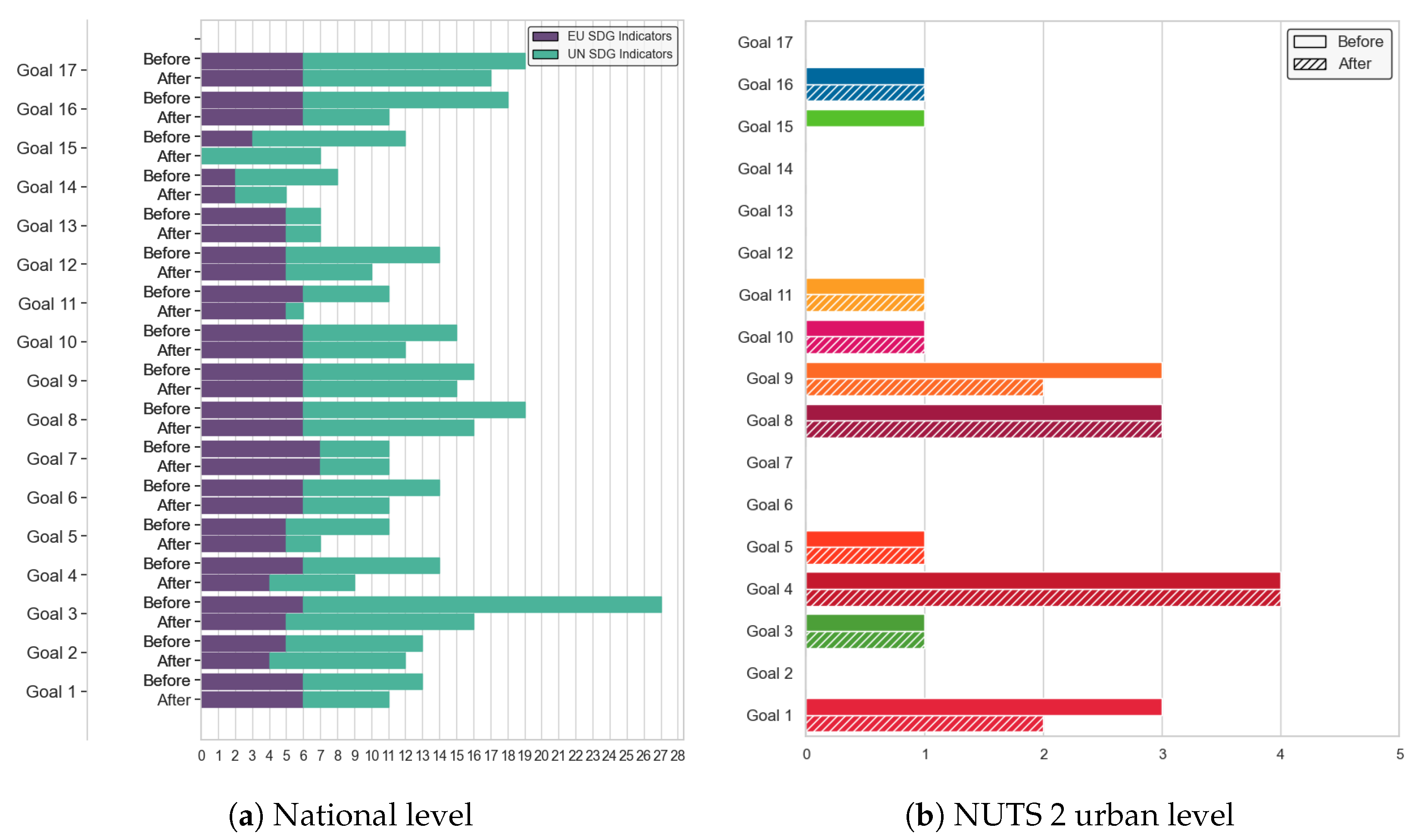
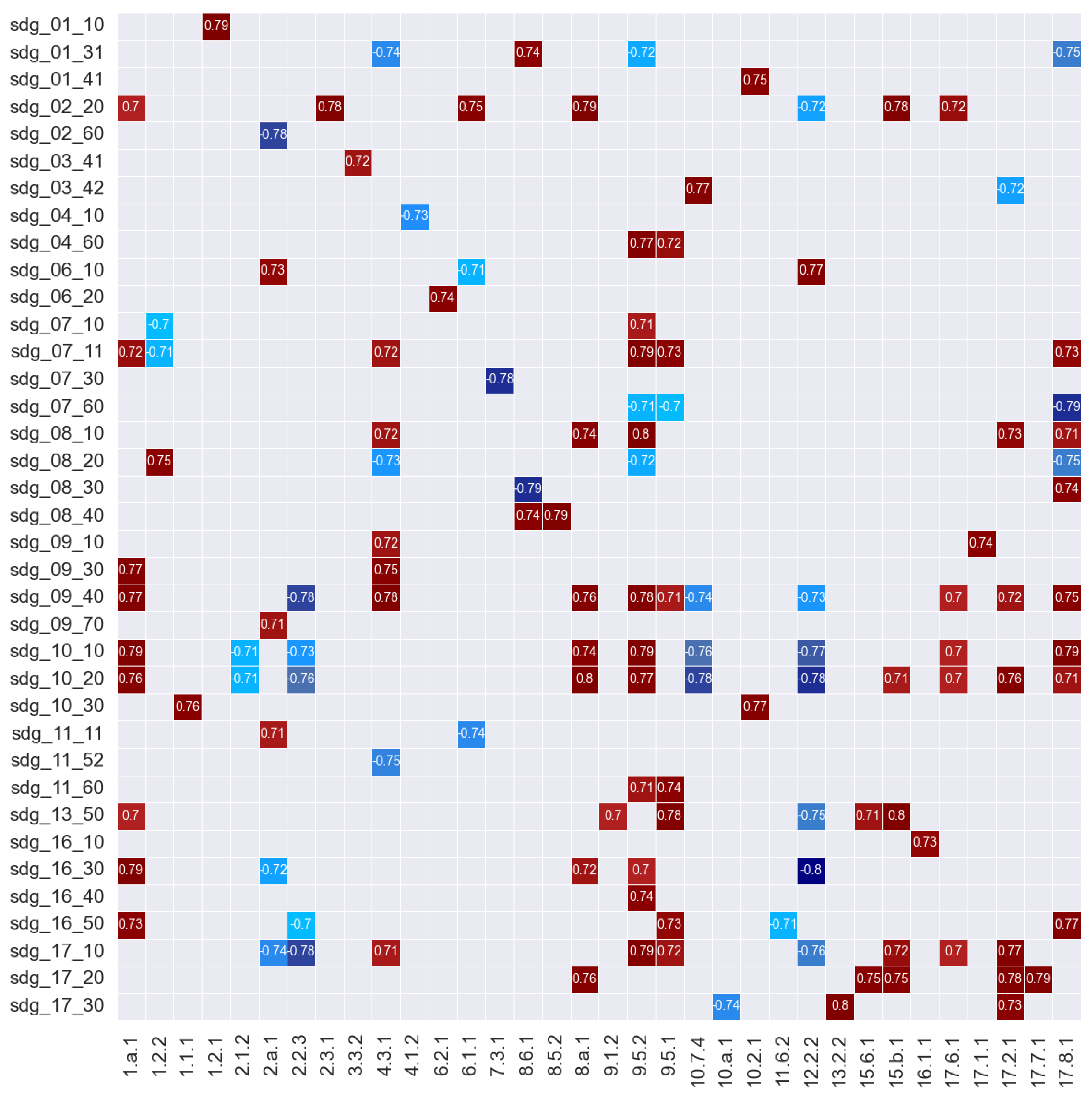



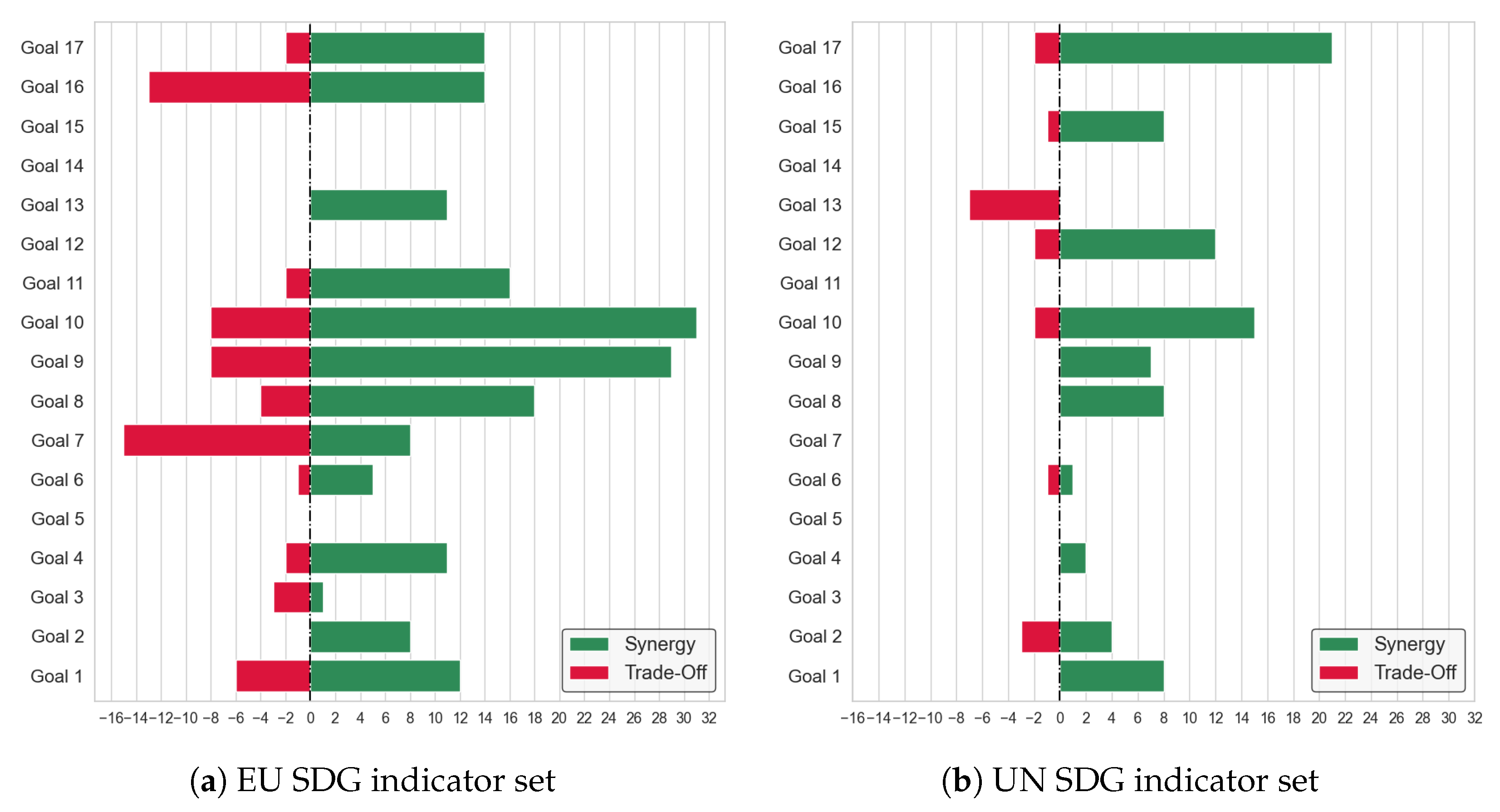


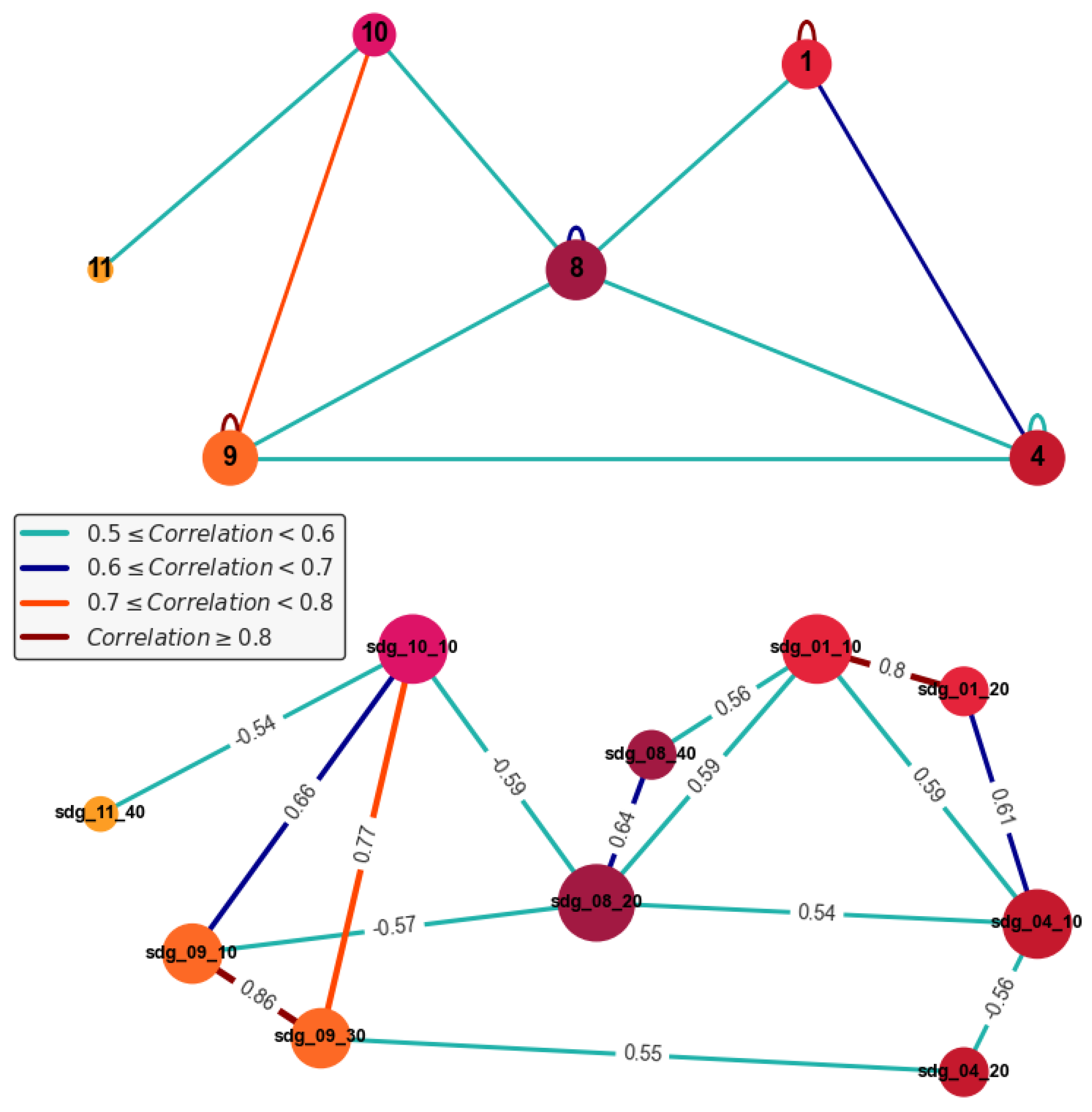
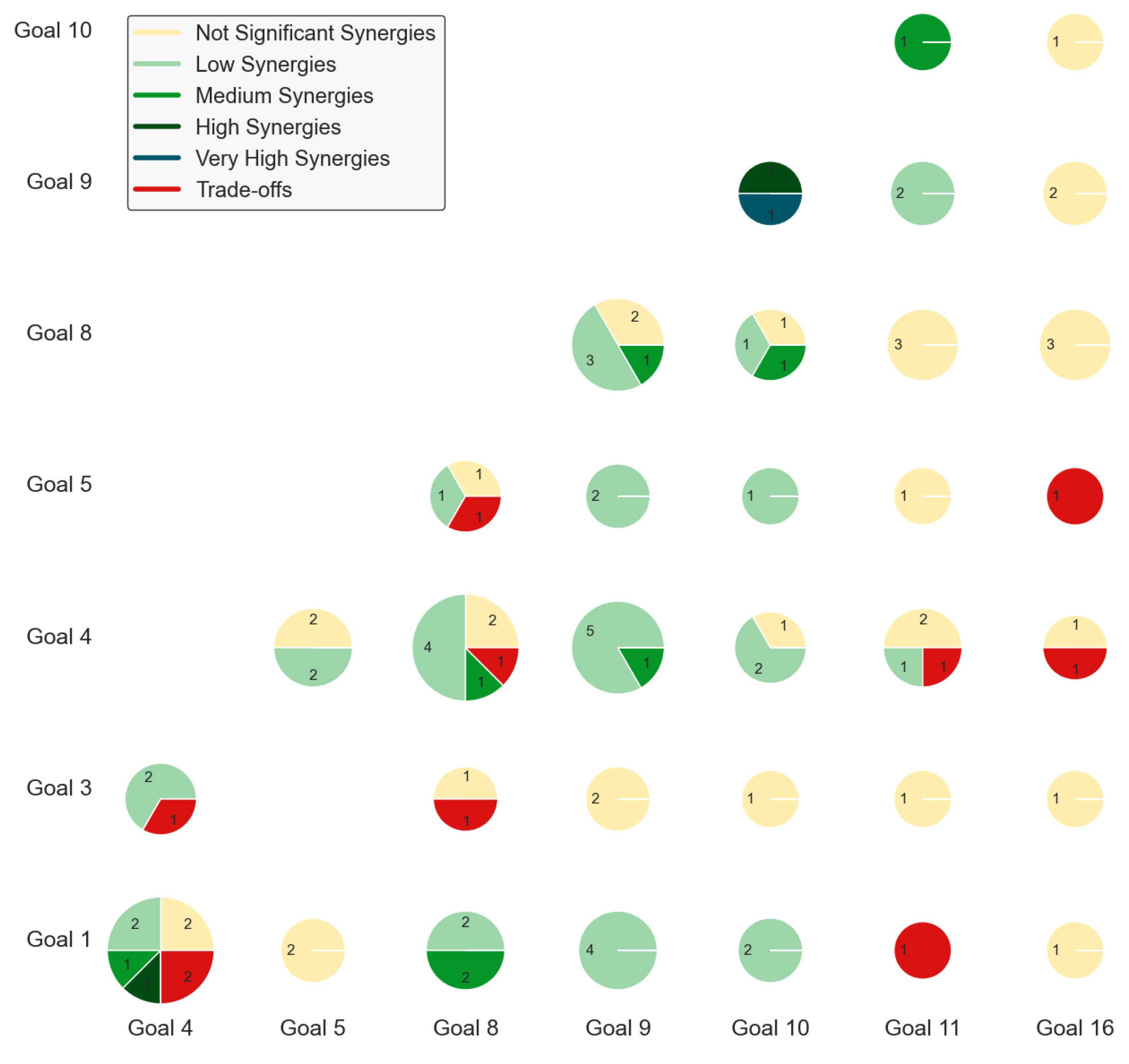
| Step | National Level | NUTS 2 Urban Level |
|---|---|---|
| Original dataset | 231 (UN), 102 (EU) | 21 (EU) |
| Indicators available in EU-27 countries and the associated Urban NUTS 2 regions | 217 (UN), 95 (EU) | 21 (EU) |
| Indicators with data availability in the period from 2000 to 2023 | 217 (UN), 95 (EU) | 21 (EU) |
| Indicators with data availability in at least half of the geoAreas | 159 (UN), 92 (EU) | 19 (EU) |
| Indicators upon excluding those with Boolean values | 150 (UN), 92 (EU) | 19 (EU) |
| Indicators upon the qualitative data assessment | 99 (UN), 84 (EU) | 16 (EU) |
| Step | Percentage of Missing Values (National Level) | Percentage of Missing Values (NUTS 2 Urban Level) |
|---|---|---|
| Selection of the optimal time period | 10% | 17% |
| Application of time interpolation technique | 3% | 4% |
| Application of the KNN imputer | 0% | 0% |
| EU SDG Indicator | UN SDG Indicator | Correlation Value |
|---|---|---|
| sdg_01_10: People At Risk Of Poverty Or Social Exclusion | 1.2.2: Proportion of men, women and children of all ages living in poverty in all its dimensions according to national definitions | 0.96 |
| sdg_01_20: Persons At Risk Of Monetary Poverty After Social Transfers—Eu-Silc And Echp Surveys | 1.2.1: Proportion of population living below the national poverty line, by sex and age | 0.91 |
| sdg_07_40: Share Of Renewable Energy In Gross Final Energy Consumption By Sector | 7.2.1: Renewable energy share in the total final energy consumption | 0.98 |
| sdg_09_10: Gross Domestic Expenditure On R&D By Sector | 9.5.1: Research and development expenditure as a proportion of GDP | 1 |
| sdg_17_10: Official Development Assistance As Share Of Gross National Income (Source: Dg Intpa, Oecd) | 17.2.1: Net official development assistance, total and to least developed countries, as a proportion of the Organization for Economic Cooperation and Development (OECD) Development Assistance Committee donors’ gross national income (GNI) | 0.77 |
| EU SDG Indicator | UN SDG Indicator | Correlation Value |
|---|---|---|
| sdg_01_20: Persons At Risk Of Monetary Poverty After Social Transfers—Eu-Silc And Echp Surveys | 10.2.1: Proportion of people living below 50 per cent of median income, by sex, age and persons with disabilities | 0.82 |
| sdg_04_31: Participation In Early Childhood Education By Sex (Children Aged 3 And Over) | 4.2.2: Participation rate in organized learning (one year before the official primary entry age), by sex | 0.38 |
| sdg_04_60: Adult Participation In Learning In The Past Four Weeks By Sex | 4.3.1: Participation rate of youth and adults in formal and non-formal education and training in the previous 12 months, by sex | 0.97 |
| sdg_05_50: Seats Held By Women In National Parliaments And Governments (Source: Eige) | 5.5.1: Proportion of seats held by women in (a) national parliaments and (b) local governments | 0.69 |
| sdg_05_60: Positions Held By Women In Senior Management Positions (Source: Eige) | 5.5.2: Proportion of women in managerial positions | 0.22 |
| sdg_06_60: Water Exploitation Index, Plus (Wei+) (Source: Eea) | 6.4.2: Level of water stress: freshwater withdrawal as a proportion of available freshwater resources | 0.69 |
| sdg_07_30: Energy Productivity | 7.3.1: Energy intensity measured in terms of primary energy and GDP | −0.78 |
| sdg_08_10: Real Gdp Per Capita | 8.1.1: Annual growth rate of real GDP per capita | −0.3 |
| sdg_08_20: Young People Neither In Employment Nor In Education And Training By Sex (Neet) | 8.6.1: Proportion of youth (aged 15–24 years) not in education, employment or training | 0.94 |
| sdg_09_70: Air Emission Intensity From Industry | 9.4.1: CO2 emission per unit of value added | 0.4 |
| sdg_10_10: Purchasing Power Adjusted Gdp Per Capita | 8.1.1: Annual growth rate of real GDP per capita | −0.22 |
| sdg_10_41: Income Distribution | 10.2.1: Proportion of people living below 50 per cent of median income, by sex, age and persons with disabilities | 0.83 |
| sdg_11_60: Recycling Rate Of Municipal Waste | 12.5.1: National recycling rate, tons of material recycled | 0.63 |
| sdg_16_10: Standardised Death Rate Due To Homicide By Sex | 16.1.1: Number of victims of intentional homicide per 100,000 population, by sex and age | 0.73 |
| sdg_17_20: Eu Financing To Developing Countries By Financing Source (Source: Oecd) | 10.b.1: Total resource flows for development, by recipient and donor countries and type of flow (e.g., official development assistance, foreign direct investment and other flows) | 0.97 |
Disclaimer/Publisher’s Note: The statements, opinions and data contained in all publications are solely those of the individual author(s) and contributor(s) and not of MDPI and/or the editor(s). MDPI and/or the editor(s) disclaim responsibility for any injury to people or property resulting from any ideas, methods, instructions or products referred to in the content. |
© 2024 by the authors. Licensee MDPI, Basel, Switzerland. This article is an open access article distributed under the terms and conditions of the Creative Commons Attribution (CC BY) license (https://creativecommons.org/licenses/by/4.0/).
Share and Cite
Androna, C.M.; Mandilara, I.; Fotopoulou, E.; Zafeiropoulos, A.; Papavassiliou, S. A Knowledge Graph-Driven Analysis of the Interlinkages among the Sustainable Development Goal Indicators in Different Spatial Resolutions. Sustainability 2024, 16, 4328. https://doi.org/10.3390/su16114328
Androna CM, Mandilara I, Fotopoulou E, Zafeiropoulos A, Papavassiliou S. A Knowledge Graph-Driven Analysis of the Interlinkages among the Sustainable Development Goal Indicators in Different Spatial Resolutions. Sustainability. 2024; 16(11):4328. https://doi.org/10.3390/su16114328
Chicago/Turabian StyleAndrona, Christina Maria, Ioanna Mandilara, Eleni Fotopoulou, Anastasios Zafeiropoulos, and Symeon Papavassiliou. 2024. "A Knowledge Graph-Driven Analysis of the Interlinkages among the Sustainable Development Goal Indicators in Different Spatial Resolutions" Sustainability 16, no. 11: 4328. https://doi.org/10.3390/su16114328
APA StyleAndrona, C. M., Mandilara, I., Fotopoulou, E., Zafeiropoulos, A., & Papavassiliou, S. (2024). A Knowledge Graph-Driven Analysis of the Interlinkages among the Sustainable Development Goal Indicators in Different Spatial Resolutions. Sustainability, 16(11), 4328. https://doi.org/10.3390/su16114328







